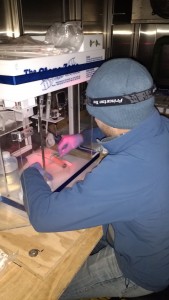by Tom Lankiewicz, University of California Santa Barbara
There are over 100 million bacterial cells in every liter of seawater from the open ocean, but we know very little about these organisms. Most ocean bacteria behave differently from common bacteria, such as E. coli or Salmonella, which are the source of most scientific knowledge on bacteria. Sequencing DNA of bacteria in ocean water allows scientists to see which bacteria are present and to gain a glimpse into the potential behavior of these bacteria with relative ease.
However, DNA is only an indicator of potential bacterial activities. To learn what these bacteria actually do, including the chemical reactions they facilitate, scientists must use other methods. One of the best ways to study growth and metabolic processes of bacterial cells is to grow them in the laboratory.

Tom Lankiewicz works in one of Sikuliaq’s temperature controlled rooms to add bacterial cells into the growth medium he created from ALOHA station seawater. Photo by Joseph Niehaus.
My task onboard R/V Sikuliaq is to isolate some of these previously uncultivated bacterial cells from the ocean. After isolating these bacterial cells, I will grow them in my lab to better understand their growth rates, metabolisms, and ultimately their roles in nutrient cycling in the ocean.
Cultivating bacteria from the open ocean is a challenging task that, in many ways, can be thought of as a game of matching. To succeed, I must match the conditions these bacteria live in while in the ocean so I can ensure the cells I am trying to grow have everything they might need to survive and flourish. The best way to go about matching these ocean conditions is to grow the cells in a liquid, called a growth medium that was created using the actual seawater they came from.
To get seawater and bacterial cells from the same water mass in the ocean requires a two-step (and two research cruise) process that began two weeks ago. I first collected approximately 200 liters of seawater from Station ALOHA (A Long-term Oligotrophic Habitat Assessment), a study site about 100 kilometers north of the Hawaiian Island of Oahu. This study site is part of the Hawaii Ocean Time-series program, or HOT, which has been taking biological and chemical measurements at a monthly frequency since 1988 to develop better understanding of chemistry and microbiology in the open ocean. We used Sikuliaq’s CTD rosette to collect this water at specific depth intervals. Using a CTD and other instruments that attach to it, we can collect information on several important water characteristics including salinity (conductivity), temperature, and depth, as well as concentrations of oxygen, chlorophyll, and particles.
The HOT team graciously allowed me to participate in their research cruise from November 25th through November 29th on Sikuliaq. During this HOT cruise and onshore, with generous resources lent to me by the Center for Microbial Oceanography Research and Education (C-MORE) at the University of Hawaii, I filtered and sterilized my collected seawater in preparation for my cultivation effort and to create the growth medium. After filtration and sterilization, I added various food sources for bacteria to the growth medium and returned to Sikuliaq.
Upon re-boarding Sikuliaq, we returned immediately to Station ALOHA and I collected another 300 liters of seawater using the ship’s CTD rosette to start my new cultures of marine bacteria. I took several subsamples of water at Station ALOHA to measure concentrations of dissolved organic carbon, nutrients, and bacterial cells. Additionally, I took samples of bacterial DNA for sequencing. Between my samples and the information gathered from Sikuliaq’s instrumentation I should be able to gain a well-rounded picture of the microbial community that my new cultures were taken from.
Starting my new bacterial cultures was then simply a matter of diluting bacterial cells from my new seawater into the growth medium I had previously created. This process must be done in the cold and dark to match the temperature and light conditions that these cells normally live in. I spent lot of time in Sikuliaq’s walk-in refrigerator to keep my bacterial cultures cold and dark!
This is only the beginning of this cultivation effort. From here on out I will need to let these new cultures sit for more than a month before checking them to see if cells have grown in the medium. I have around 1200 new cultures to check. I will count the cells from each culture with an instrument called a flow cytometer, which uses a laser to count microscopic cells that have been stained with a fluorescent dye. After seeing which cultures have successfully grown, I will need to transfer them into new growth medium and allow them to continue to multiply before characterizing the cells using controlled experiments. I will also sequence the DNA of the new cultures to identify them and to further study their genomes.
I owe a big thank you to the entire crew of Sikuliaq, but especially our marine technicians Steve Hartz and Bern McKiernan, who have made my operations onboard run exceptionally smoothly. Thanks, All!
